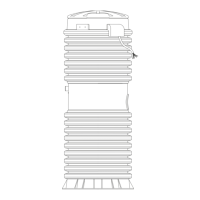14
Alarm On — Pump not Operating
Check the voltage at a location nearest the pump, such as the
junction box or electrical quick disconnect (EQD) plug. The correct
voltage is listed on the pump nameplate. Note: Voltage must be
within 10 percent of nameplate voltage (240V: 216 to 264V; 120V:
108V to 132V). 208V requires a transformer to boost voltage.
Check the Equalizer Tube connected to the Equalizer and make
sure that it isn't crimped or pinched.
Check the tank for sufficient fluid to activate the alarm. Insufficient
fluid may indicate a problem with the alarm wiring, the alarm
sensing line or the alarm switch. Chapter 9 – Level Sensor and
Chapter 10 Control Cavity, describes the process for checking the
alarm wiring and controls.
Inspect the electrical controls. Replace any wet or corroded
controls. See Chapter 10 – Control Cavity.
Test the controls as described in Chapter 10 – Control Cavity
Table 3 – 8
Alarm Activates Frequently
The incoming flow is greater than the pump can handle. Infiltration,
a sump pump, a hot tub or any other device that causes excessive
water flow can cause high flow.
Plugged Vent or
Equalizer Tube
Check the Vent and the Equalizer Tube. A plugged or partially
plugged Vent or Equalizer Tube may cause the alarm to activate
frequently. Replace the Equalizer Tube if kinked or damaged.
Pull the pump out of the tank. Inspect the Level Sensors for leaks
and debris; use Level Sensor test to check for leaks.
Line Blockage or
Worn Stator
Check the amperage. If the amperage is high, look for a line
blockage. If the amperage is low, inspect the Stator for excessive
wear.
Check the Tray Cable wiring for cuts, breaks and shorts. Use a
Megohm Meter to check for shorts between each pair of leads.
Replace the Tray Cable if a short is found.
Table 3 – 9

